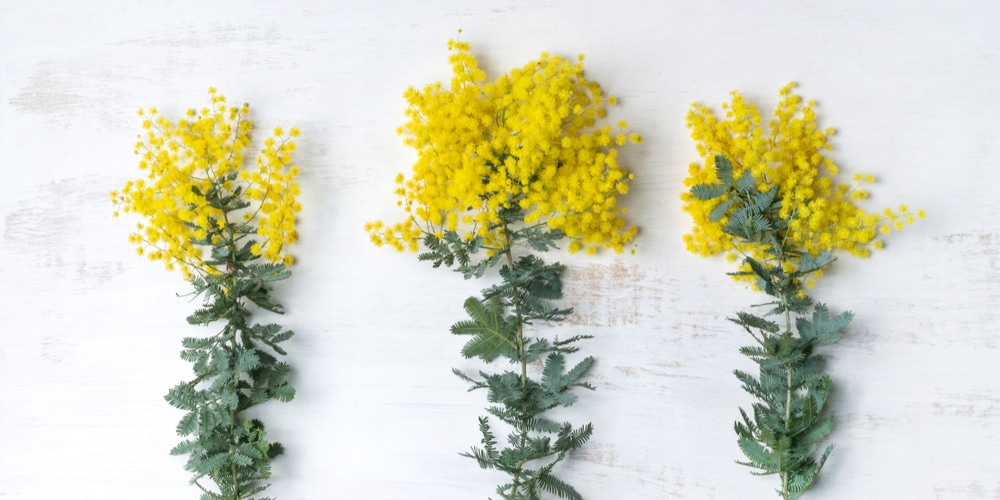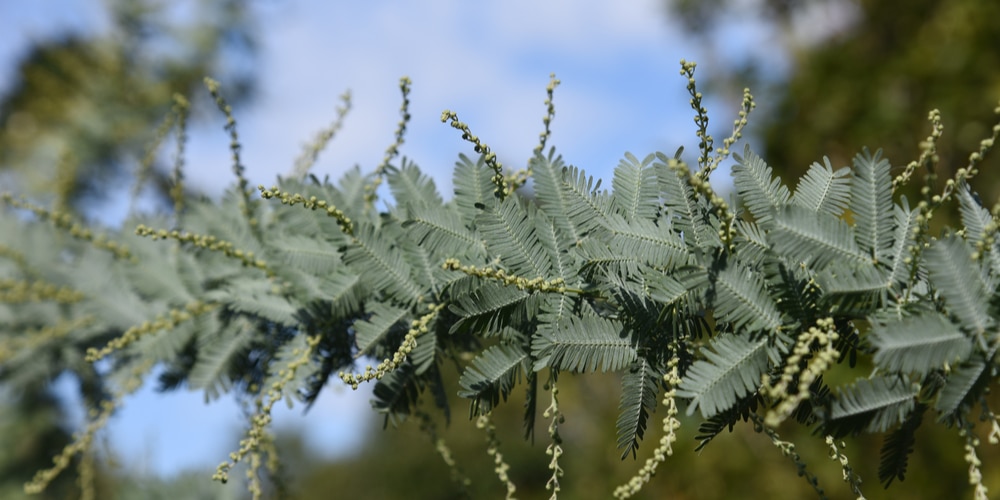Acacia Baileyana is an elegant-looking shrub perfect for adding volume and texture to your outdoor spaces. Its vividly-colored flowers will make your garden more attractive to beneficial pollinators.
The colorful plant will make spending time in your yard more pleasant! To learn more about growing this charming plant, keep reading!
| Botanical Name | Cootamundra wattle |
| Common Name | Acacia Baileyana or Bailey Acacia tree |
| Plant Type | Perennial |
| Flower Color | Bright yellow, small, and rounded |
| Size When Mature | Up to 20 ft tall and wide |
| Bloom Time | Late winter to early spring |
| Sun Requirements | Full Sun |
| USDA Hardiness Zones | 9-10 |
| Soil PH Range | 5.5 to 7.0 |
| Soil Type | Well-draining, moist, neutral to acidic |
| Water Needs | Medium |
| Native Area | Australia |
What you Need to Know About Acacia Baileyana
Acacia Baileyana is a medium-size shrub (that you can also grow as a small tree) that might reach as much as 20 feet in height. It performs well around borders, especially in Mediterranean gardens. With its widespread canopy and attractive blooms, this plant contributes to making a dramatic statement in your yard. This plant is relatively short-lived and not particularly challenging to grow, perfect for beginner gardeners.
This plant isn’t toxic to humans or animals, making it a safe choice if you have kids or pets running around your garden.
How to Care for Acacia Baileyana
Under optimal climates, growing acacia Baileyana isn’t a challenging task. Still, you’ll want to know how to meet its requirements to get the most out of it. Keep reading to learn all you need to know to grow a thriving acacia Baileyana in your yard.
Light
Acacia trees and shrubs need plenty of sunlight to thrive. Ensure you plant your Bailey acacia in a location that receives at least six hours of direct sun every day.
Water and Soil Needs
This plant grows best in moist and well-draining soils. Consider adding sand or gravel to your substrate to reduce compaction. Also, you may want to add a thick layer of mulch around your plant to increase drainage and improve water retention. While the plant isn’t too picky about soil pH, it will do much better in slightly acidic to neutral conditions. Consider carrying out a soil test and amend your substrate if necessary.
We recommend you water your plant thoroughly and allow the soil to dry in between moisture applications. Indeed, frequent watering might result in shallow roots and could cause rotting.
Adjust your watering schedule depending on your local climate conditions. As a rule of thumb, you should water your Bailey Acacia once every one or two weeks.
Temperature Requirements
This plant is native to Australia, meaning it has a low tolerance to cold temperatures. Acacia Baileyana thrives in USDA hardiness zones 9-10 and won’t survive frost. Always keep an eye on your local weather to protect your plant from cold snaps.
If you live in a colder region, you can grow your plant in a container and move it indoors over the winter. Mulching is imperative under such conditions because it will help regulate the soil temperature and protect your plant from thermal shock.
Fertilizer
While it isn’t necessary, adding fertilizer will boost your plant’s growth and enhance blooming. Purchase a high-quality and slow-release product for the best result. Pick a balanced fertilizer to encourage flowering and avoid getting a leggy plant.
Alternatively, you can add compost or manure around your plants. Doing so will improve the soil’s nutrient content and increase drainage, which is never a bad idea for a plant that likes moist environments.
Common Diseases
Acacia Baileyana is an easy target for scale and spider mites, who love to feed on the plant’s sap and leaves. If you notice holes in the foliage, you’ll probably have to take action to remove the infestation. Make sure you take prompt action to prevent destruction.
You can use a garden hose to spray the branches with water to drown the insects and get rid of them. However, such a method will be effective if the infestation isn’t severe. If it is, purchasing an insecticide will save you plenty of headaches.
Additionally, don’t forget to prune your plant regularly. Doing so will ensure adequate airflow and reduce the probability of fungal infection and attacks from pests.
Acacia Baileyana Propagation
You can propagate your acacia Baileyana from cuttings. While the task isn’t challenging, it requires some patience from your side. To begin with, selecting healthy cuttings is crucial for success. Cut some half-hardened wood using sterile pruners. Snip them below the node and remove the lower leaf structures and flowers.
Dip the ends of your cuttings in rooting hormone and place them in containers filled with suitable potting soil. We suggest you start your cuttings indoors: it will increase your chances of success! With proper care, you’ll start seeing some growth within some weeks. When the seedlings are about 5 inches tall, transplant them to a larger pot.
Consider hardening off your seedlings gradually before exposing them to outdoor conditions.
Related Article: Best Time of year to Plant Shrubs?

